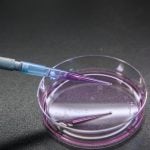BROOKS, Alta. — Spraying farm chemicals by air should not be a ‘fly-by-night’ operation.
To ensure the job is done properly, clinics are held each year. They are designed to check aerial applicators’ equipment to minimize drift problems and make sure farmers are getting their money’s worth by spraying entire fields with no missing strips.
The day-long clinics have been held across the Prairies each year since 1986 with sponsorship by applicators’ associations and chemical companies. Alberta had clinics at High River, Killam and Brooks this spring.
Read Also

Breaking down successful winter feeding into six steps
It’s that time of year when it is important to start planning for a cow herd’s winter feeding program. Here are six steps I think are necessary to consider when getting your feed tested.
Using specialized equipment and computer programs, the airplanes, their plumbing systems and nozzle flow rates are checked. Plastic bottles are attached to each nozzle on the booms below the wings, water is run through and testers watch the flow to see if all nozzles are working and if the spray is even, said Brooks pilot Tim Boyd.
Right on target
The planes then do a fly-by test spraying colored water over a designated site where instruments record plane speed and altitude. Each plane passes over a 30-metre-long string three times to see if they’re hitting their target. The string is then checked and adjustments can be made to nozzles and tanks to get the best coverage. If the pattern on the string is uneven, then crews know where repairs are needed.
A computer printout charts weather conditions, height and speed of the plane as well as an analysis of the patterns on the string showing the spray’s coverage as a series of depressions and peaks.
The goal is to produce an even spray pattern, said Boyd. The computer can also calculate how much pesticide is supposed to come out and whether the application rate is correct.
Training encouraged
These clinics are not mandatory but aerial applicators’ associations are encouraging companies and their pilots to do it, said Jim Wilkie of Miles Canada Inc., one of the clinic sponsors.
Talk is also afoot for the same kind of clinic for ground applicators, said Wilkie.
Wind and faulty application equipment, variables like air disturbance close to the ground, and exhaust from the plane or ground sprayer affect coverage. Swirling dust from tires can also reduce effectiveness of the pest control.
Brian Kinniburgh, a past-president of the Canadian Aerial Applicators Association, wants people to know pilots in his business are trying to be conscientious. His association promotes the clinics and would like to see all applicators belong to a provincial association because it could better police the way chemicals are applied.
To do this kind of work the pilots must have a pesticide applicator’s licence and must either take a course or show they know what they’re doing by writing an exam, said Kinniburgh, whose family has an aerial spraying company at Taber.
The licence is renewed every three years and if anything is amiss, Alberta Environment pulls the licence for as long as the department sees fit, said Kinniburgh. Alberta has 45 licensed applicators.
“The most highly regulated method of (chemical) application is aerial,” he said.
Due to their high visibility as they work in the air, it’s not uncommon to receive complaints from people who suspect aerial applicators have poisoned trees and other crops because of pesticides drifting on the wind.
This group works closely with the Canadian Crop Protection Institute and is trying to abide by the guidelines set up by this organization for proper warehousing, transportation and handling of chemicals, Kinniburgh said.
Restrictions on what to apply
They also join those lobbying for changes to pesticide regulations including the right to use glyphosate (Roundup) by air. The biggest roadblock is the controversy over drift because this chemical kills anything that’s green. Some have already used it illegally, which Kinniburgh’s association doesn’t endorse.
“Our biggest problem is a lack of products that we can apply by air,” he said. Applicators like Kinniburgh find the list of allowable chemicals grows shorter each year.
Air spraying is preferable when the ground is wet, and fungicides for crops like potatoes are more effective because machinery doesn’t spread the disease by touching the leaves.















